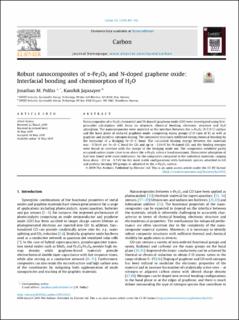| dc.contributor.author | Polfus, Jonathan M. | |
| dc.contributor.author | Jayasayee, Kaushik | |
| dc.date.accessioned | 2020-12-23T12:07:42Z | |
| dc.date.available | 2020-12-23T12:07:42Z | |
| dc.date.created | 2019-08-07T09:12:42Z | |
| dc.date.issued | 2019 | |
| dc.identifier.citation | Carbon. 2019, 152 497-502. | en_US |
| dc.identifier.issn | 0008-6223 | |
| dc.identifier.uri | https://hdl.handle.net/11250/2720942 | |
| dc.description.abstract | Nanocomposites of α-Fe2O3 (hematite) and (N-doped) graphene oxide (GO) were investigated using first-principles calculations with focus on structure, chemical bonding, electronic structure and H2O adsorption. The nanocomposites were modeled as the interface between the α-Fe2O3 (0 0 0 1) surface and the basal plane of reduced graphene oxide, comprising epoxy groups (C:O ratio of 8) as well as graphitic and pyridinic nitrogen doping. The composite structures exhibited strong chemical bonding by the formation of a bridging Fe–O–C bond. The calculated binding energy between the materials was −0.56 eV per Fe–O–C bond for GO and up to −1.14 eV for N-doped GO, and the binding energies were found to correlate with the charge of the bridging oxide ion. The composites exhibited partly occupied carbon states close to or above the α-Fe2O3 valence band maximum. Dissociative adsorption of H2O was found to be more exothermic for the composites compared to the individual materials, ranging from about −0.9 to −1.7 eV for the most stable configurations with hydroxide species adsorbed to GO and protons forming NH groups or adsorbed to the α-Fe2O3 surface. | en_US |
| dc.language.iso | eng | en_US |
| dc.publisher | Elsevier | en_US |
| dc.rights | Navngivelse 4.0 Internasjonal | * |
| dc.rights | Navngivelse 4.0 Internasjonal | * |
| dc.rights.uri | http://creativecommons.org/licenses/by/4.0/deed.no | * |
| dc.subject | Nanocomposites | en_US |
| dc.subject | Graphene oxide | en_US |
| dc.title | Robust nanocomposites of a-Fe2O3 and N-doped graphene oxide: Interfacial bonding and chemisorption of H2O | en_US |
| dc.type | Peer reviewed | en_US |
| dc.type | Journal article | en_US |
| dc.description.version | publishedVersion | en_US |
| dc.rights.holder | ©2019 The Authors. Published by Elsevier Ltd. This is an open access article under the CC BY license (http://creativecommons.org/licenses/by/4.0/).Carbon 152 (2019) 497e502 | en_US |
| dc.source.pagenumber | 497-502 | en_US |
| dc.source.volume | 152 | en_US |
| dc.source.journal | Carbon | en_US |
| dc.identifier.doi | 10.1016/j.carbon.2019.05.033 | |
| dc.identifier.cristin | 1714471 | |
| dc.relation.project | Norges forskningsråd: 262274 | en_US |
| dc.relation.project | Norges forskningsråd: 246809 | en_US |
| dc.relation.project | Notur/NorStore: NN9259K | en_US |
| cristin.unitcode | 7401,80,62,0 | |
| cristin.unitname | Bærekraftig energiteknologi | |
| cristin.ispublished | true | |
| cristin.fulltext | original | |
| cristin.qualitycode | 2 | |

